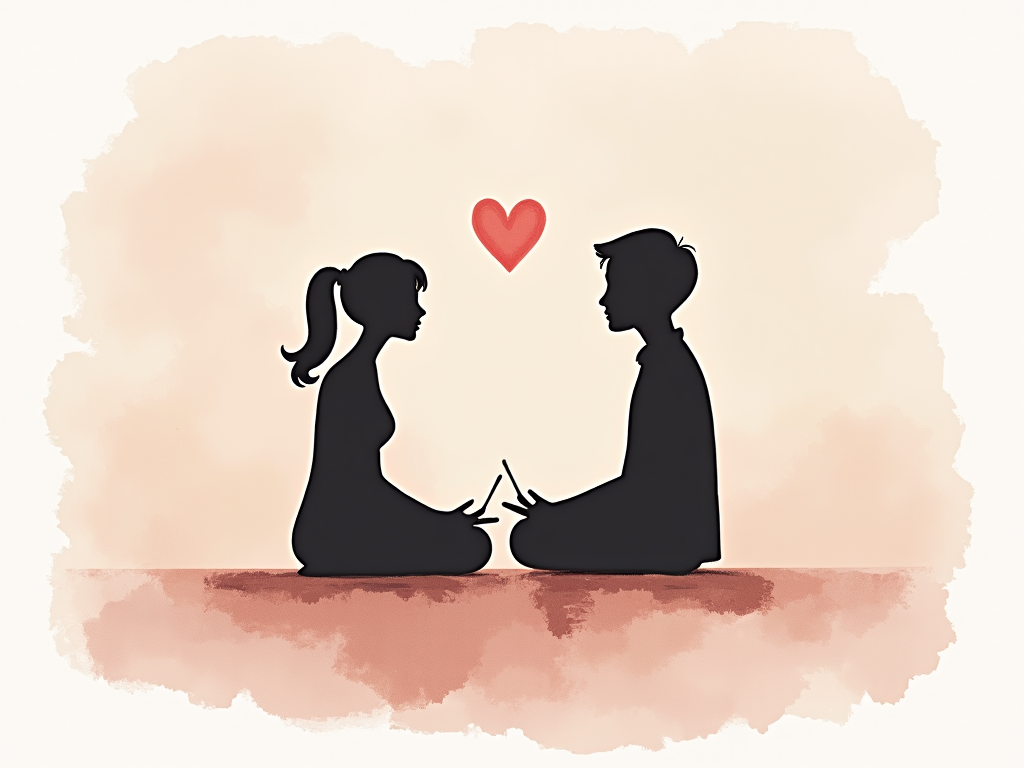
Taking a Texting Break in Relationships: What I Discovered When My Boyfriend Stopped Messaging
Reading time: 8 minutes
Table of Contents
- The Moment I Realized Something Had Changed
- Understanding Modern Communication Patterns
- Our One-Week Communication Break Experiment
- 5 Unexpected Lessons I Learned
- What Relationship Experts Say About Texting Frequency
- Different Communication Styles in Relationships
- Revitalizing Your Digital Connection
- Your Communication Reset Button: Creating Healthier Patterns
- Frequently Asked Questions
The Moment I Realized Something Had Changed
I still remember the exact moment I realized something had shifted. Three months into our relationship, my phone—once lighting up every few minutes with his messages—had grown eerily quiet. The “good morning” texts became sporadic, and conversations that once flowed effortlessly now felt like pulling teeth. That familiar flutter in my stomach when seeing his name on my screen was replaced by a growing knot of anxiety.
“Did I do something wrong?” “Is he losing interest?” “Should I double text or play it cool?” The questions swirled in my mind, creating a vortex of uncertainty that affected not just our relationship but my entire day.
If you’ve ever experienced the subtle shift in communication frequency with a partner, you know exactly how destabilizing it can feel. In today’s digital-first dating landscape, text messages have become powerful relationship currency—their presence or absence carrying significant emotional weight.
What started as a concerning development in my relationship eventually led to a revelatory experiment: a one-week intentional communication break that transformed not just how we text, but how we connect on a fundamental level.
Understanding Modern Communication Patterns
Today’s relationships exist in an unprecedented communication environment. A 2022 study by the Journal of Social and Personal Relationships found that the average couple exchanges 72 texts per day during the first year of dating—that’s approximately one message every 13 minutes during waking hours.
The data reveals an interesting pattern: messaging frequency typically follows a predictable arc in relationships:
Dr. Michelle Drouin, a technology and relationships researcher, explains: “What we perceive as a ‘decrease’ in communication is often just a natural stabilization. The initial surge of messages creates an unsustainable baseline that inevitably adjusts as the relationship finds its rhythm.“
But understanding this pattern intellectually doesn’t always soothe our emotional response when our phones fall silent. The real question becomes: is your communication changing because you’re entering a new relationship phase, or is something else at play?
The Anxiety-Inducing Power of Message Bubbles
The psychological weight of digital communication can’t be overstated. A 2023 survey by The Pew Research Center found that 67% of adults under 30 report feeling anxious when their partner’s texting habits change—a phenomenon termed “textpectation anxiety” by relationship psychologists.
For Mia, 28, this anxiety became overwhelming: “When Jake went from texting all day to maybe twice daily, I spiraled. I’d stare at read receipts, analyzing the minutes between responses. I’d draft messages, delete them, then feel ridiculous for obsessing. It was exhausting.”
This anxiety isn’t just uncomfortable—it can lead to relationship-damaging behaviors:
- Message monitoring: Constantly checking for replies and last seen statuses
- Text spiraling: Sending multiple follow-up messages when responses are delayed
- Digital surveillance: Tracking social media activity to see if they’re online but not responding
- Content overanalysis: Scrutinizing message length, tone, and punctuation for hidden meanings
These behaviors often create the very distance we fear, creating a self-fulfilling cycle of communication breakdown.
Our One-Week Communication Break Experiment
When my boyfriend’s texting frequency dropped significantly, my initial reaction was to double down—sending more messages, asking more questions, essentially trying to recreate our earlier pattern through sheer effort. The results were predictably disappointing.
After a particularly strained phone call where neither of us seemed to have much to say (yet both felt frustrated by the interaction), I suggested something that felt both terrifying and necessary: a one-week break from all digital communication.
The rules were simple:
- No texting, calling, or social media interaction for seven days
- We could message only for absolute emergencies
- We’d meet in person after the week to discuss what we learned
- Both would journal our thoughts and feelings during the experiment
My boyfriend seemed relieved by the suggestion, which initially stung but ultimately validated that something needed to change. We set a start date and prepared for a week of digital silence.
The Initial Withdrawal
The first 48 hours were genuinely uncomfortable. I caught myself reaching for my phone dozens of times to share random thoughts or ask how his day was going. Each time, I’d remember our agreement and put my phone down, sitting with the discomfort of not knowing what he was doing or thinking.
By day three, something unexpected happened: the anxiety began to dissipate. Without the constant pressure to respond, analyze, and maintain digital contact, I found myself more present in my daily activities. The mental space previously occupied by message monitoring was gradually filled with other thoughts and experiences.
5 Unexpected Lessons I Learned
Our in-person reunion after seven days was illuminating. We spent hours talking, comparing notes from our journals, and discovering insights that have fundamentally changed our approach to communication.
1. We Had Developed a “Connection Illusion”
Perhaps the most startling realization was that our constant texting had created what therapists call a “connection illusion”—the false sense that digital exchanges equate to meaningful interaction. When we stripped away the steady stream of “how’s your day?” messages, we discovered how little substance many of our exchanges contained.
My boyfriend admitted, “I was answering your texts while multitasking, often not fully engaged. I started feeling like I had nothing new to say because we never gave ourselves time to accumulate experiences worth sharing.”
This explained why our phone calls had become strained—we’d already distributed our thoughts in small, diluted doses throughout the day, leaving little for deeper conversation.
2. My Self-Worth Was Tied to Digital Validation
Journaling revealed an uncomfortable truth: I had unconsciously tied my sense of value in the relationship to message frequency. Each text was a reassurance that I mattered, while delayed responses triggered disproportionate insecurity.
Relationship coach Esther Perel describes this common pattern: “When we outsource our self-worth to digital response patterns, we create a fragile foundation for connection. The relationship becomes a constant reassurance mechanism rather than a space for authentic engagement.“
3. We Had Different Communication Needs
Our journals revealed a fundamental mismatch in our communication preferences that had gone unarticulated. I discovered that my boyfriend experienced “text fatigue”—feeling drained by the expectation to maintain constant contact. Meanwhile, I interpreted frequent messaging as a sign of care and investment.
Neither approach was wrong, but our failure to discuss these differences had created unnecessary tension.
4. Quality Conversations Require Space
When we finally reunited, our conversation had a depth and energy that had been missing for weeks. We had stories to tell, observations to share, and questions that came from genuine curiosity rather than obligation.
This space between communications allowed for:
- Processing experiences individually before sharing them
- Developing independent thoughts and perspectives
- Building genuine anticipation to reconnect
- Creating the psychological space needed for reflection
5. Digital Communication Has Diminishing Returns
The data visualization below illustrates one of our key discoveries: the relationship between texting frequency and perceived connection follows a bell curve rather than a straight line:
Connection Quality by Daily Text Frequency
65% satisfaction
85% satisfaction
70% satisfaction
40% satisfaction
Based on relationship satisfaction surveys and our personal experience
Too little communication creates distance, but excessive messaging can be equally problematic, creating fatigue and diminishing the value of each interaction.
What Relationship Experts Say About Texting Frequency
After our experiment, I consulted relationship experts to understand the broader context of our experience. Their insights validated much of what we discovered firsthand.
Dr. John Gottman, renowned relationship researcher, explains: “The goal isn’t a specific number of messages, but rather a communication rhythm that works for both partners. Problems arise when there’s a mismatch in expectations that goes unaddressed.“
Clinical psychologist Dr. Ramani Durvasula adds: “Constant digital contact can actually prevent deeper connection by creating the illusion of intimacy without the vulnerability required for authentic bonding. Many couples are together all day digitally but struggle with emotional intimacy in person.“
The key takeaway from experts is that communication quality and alignment of expectations matter far more than absolute frequency.
Different Communication Styles in Relationships
Our experiment helped us identify our distinct communication preferences, which explained much of our previous tension. Understanding these styles can help you recognize your own patterns:
The Continuous Connector
This style (which I identified with) values frequent check-ins and ongoing conversation throughout the day. For Continuous Connectors, consistent communication feels reassuring and demonstrates care.
Signs you might be a Continuous Connector:
- You feel most secure when in regular contact
- Gaps in communication trigger worry or insecurity
- You enjoy sharing small moments and random thoughts
- You often initiate conversations and check-ins
The Intentional Communicator
This style (which my boyfriend identified with) prefers fewer, more focused interactions. For Intentional Communicators, quality conversations at specific times feel more meaningful than constant updates.
Signs you might be an Intentional Communicator:
- You feel drained by constant message notifications
- You prefer to process thoughts before sharing them
- You value focused, distraction-free conversation
- You might forget to respond to messages when busy
Neither style is inherently better, but understanding these differences helps couples develop communication patterns that honor both partners’ needs. As relationship therapist Esther Perel notes, “Compatibility isn’t about identical styles—it’s about creating bridges between different approaches.“
Revitalizing Your Digital Connection
If your texting dynamic has grown stale or become a source of tension, try these strategies to refresh your digital connection:
Try a Partial Communication Fast
Our one-week experiment was transformative, but even shorter periods of intentional distance can reset unhealthy patterns. Consider:
- Text-free weekends where you connect only in person or by phone
- Designated “deep work” hours where both partners agree not to message unless urgent
- Message-free date nights where phones are put away entirely
These boundaries create the psychological space needed for more meaningful connection when you do communicate.
Quality Over Quantity Messaging Prompts
Replace routine check-ins with prompts that invite deeper sharing:
- “What was something that made you smile today?”
- “I’m curious about your thoughts on [something you both experienced]”
- “What’s something you’re looking forward to this week?”
- “I had an interesting thought about [topic] today. Can I share it with you?”
These invitations create opportunities for more meaningful exchanges than generic “how are you?” messages.
Explicitly Negotiate Communication Expectations
After our experiment, my boyfriend and I created a simple communication agreement that honors both our styles:
- One good morning text to start the day
- One midday check-in if time permits
- A brief evening call instead of multiple goodnight texts
- Freedom to not respond immediately during work hours
- A weekly “communication check-in” to address any concerns
This framework provides reassurance for my need for connection while respecting his preference for fewer interruptions—a compromise that has significantly reduced tension.
Your Communication Reset Button: Creating Healthier Patterns
If you’re feeling distant from your partner due to changing text patterns, consider this step-by-step approach to reset your digital dynamic:
- Conduct a communication audit: Review your recent exchanges. Are they meaningful or habitual? How do they make you feel?
- Identify your true communication needs: Distinguish between what makes you feel secure versus what might be attachment anxiety.
- Have an honest conversation: Share your observations without accusation, using “I” statements about your experience.
- Experiment with new patterns: Consider trying your own communication break or establishing new guidelines.
- Focus on in-person quality time: Invest energy in creating meaningful face-to-face experiences that strengthen your connection.
Remember that communication patterns naturally evolve throughout a relationship. A change in texting frequency isn’t necessarily a warning sign—it may simply indicate your relationship is maturing beyond the need for constant digital reassurance.
The strongest relationships aren’t built on message counts but on mutual understanding, respect for different needs, and the ability to adapt together as you grow. Our texting experiment didn’t just save our relationship—it transformed it into something more authentic and sustainable than before.
What communication patterns have you noticed in your relationship? Have you ever considered how a temporary distance might strengthen your connection? Sometimes, the space between messages is where the real relationship grows.
Frequently Asked Questions
Should I be worried if my boyfriend suddenly texts less often?
A change in texting patterns isn’t automatically concerning. Consider the context: Has your relationship recently become more established? Is he under new work pressure? Has your in-person connection remained strong? Before assuming decreased interest, have a direct conversation about communication preferences. Many people experience “text fatigue” as relationships develop, preferring quality exchanges over constant contact. If other aspects of your relationship remain healthy, this could simply be an evolution in your communication style.
How do I tell my partner I need more communication without seeming needy?
Frame the conversation around understanding rather than demands. Try: “I’ve noticed our texting patterns have changed, and I realized I feel most connected when we check in regularly. I’m curious about your communication preferences and how we might find a balance that works for both of us.” This approach acknowledges your needs while inviting collaborative problem-solving rather than placing blame. Focus on specific patterns that help you feel secure rather than requesting constant attention.
Is it healthy to take communication breaks in a relationship?
Intentional communication breaks can be extremely beneficial when approached thoughtfully. The key distinction is between breaks taken as punishment versus those designed for reflection and reset. A healthy communication break has clear parameters (duration, exceptions for emergencies), mutual agreement, and a plan to reconnect and discuss insights afterward. Research shows that such breaks can increase appreciation, reduce communication dependency, and create space for more meaningful connection upon reunion. However, breaks implemented unilaterally or used to avoid problems typically harm relationships.

Article reviewed by Maja Kovačević, Breakup Recovery Specialist | Healing Hearts & Rebuilding Self-Worth, on May 2, 2025
